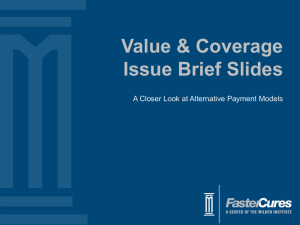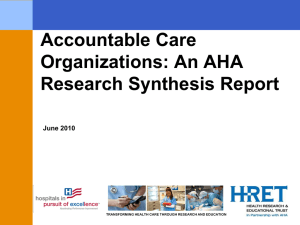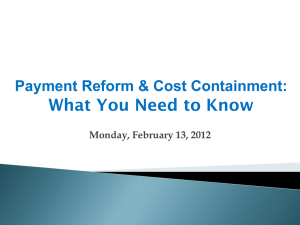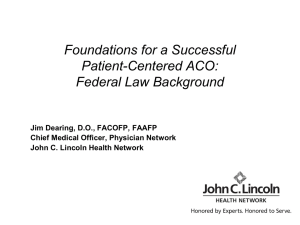Current Health Care Issue Paper
advertisement
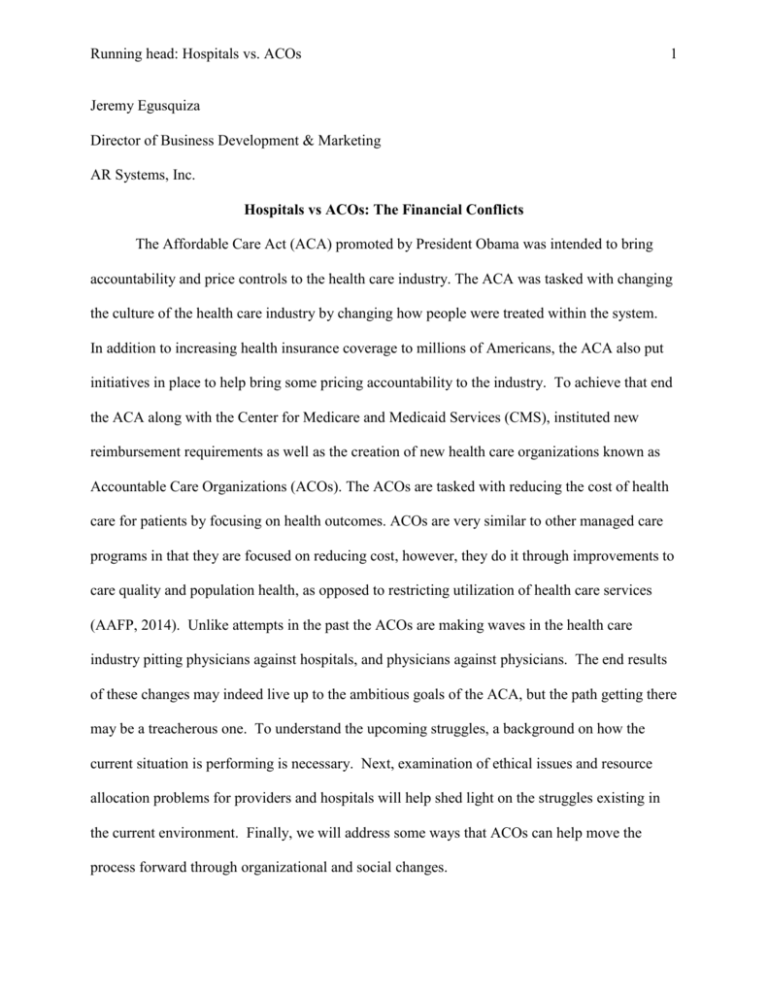
Running head: Hospitals vs. ACOs 1 Jeremy Egusquiza Director of Business Development & Marketing AR Systems, Inc. Hospitals vs ACOs: The Financial Conflicts The Affordable Care Act (ACA) promoted by President Obama was intended to bring accountability and price controls to the health care industry. The ACA was tasked with changing the culture of the health care industry by changing how people were treated within the system. In addition to increasing health insurance coverage to millions of Americans, the ACA also put initiatives in place to help bring some pricing accountability to the industry. To achieve that end the ACA along with the Center for Medicare and Medicaid Services (CMS), instituted new reimbursement requirements as well as the creation of new health care organizations known as Accountable Care Organizations (ACOs). The ACOs are tasked with reducing the cost of health care for patients by focusing on health outcomes. ACOs are very similar to other managed care programs in that they are focused on reducing cost, however, they do it through improvements to care quality and population health, as opposed to restricting utilization of health care services (AAFP, 2014). Unlike attempts in the past the ACOs are making waves in the health care industry pitting physicians against hospitals, and physicians against physicians. The end results of these changes may indeed live up to the ambitious goals of the ACA, but the path getting there may be a treacherous one. To understand the upcoming struggles, a background on how the current situation is performing is necessary. Next, examination of ethical issues and resource allocation problems for providers and hospitals will help shed light on the struggles existing in the current environment. Finally, we will address some ways that ACOs can help move the process forward through organizational and social changes. CURRENT HEALTH CARE ISSUE PAPER 2 Background on Status Quo The Affordable Care Act put the entire health care industry on notice that there needed to be changes made to keep the health care industry viable for years to come. One change that is currently being dealt with in the industry is a change from the pay-for-service reimbursement structure to pay-for-value (Jha, 2013). Pay-for-value or pay-for-performance programs are built around the idea that the payment that providers receive for their services should be based on the health outcomes and quality of care provided to the patient. The current Medicare payment structure used for ACOs is a version of a value based payment that have incentives for organizations that can meet quality of care outcome goals while keeping costs at a minimum (Burns, 2013). To achieve these goals ACOs are focusing on preventing diseases, managing patient care, and trying to prevent return visits. This premise has put ACOs in direct conflict with many hospitals because this limits the reimbursement potential of hospitals as we will see in the next section. Ethical and Resource Allocation Issues The creation of ACOs and the implement of pay-for-value reimbursement structures have created many ethical issues that often stem from resource allocation problems. As mentioned earlier the goal of ACOs and the pay-for-value systems is to reduce the overall cost of health care while at the same time improving quality of care. In its effort to fulfill these goals, ACOs are causing conflicts between themselves and hospitals, and between primary care physicians (PCP) and specialists. ACOs vs. Hospitals Hospitals are key components of the health care system as they provide centralized care facilities, high tech equipment, and facilitate the exchange of clinical information through CURRENT HEALTH CARE ISSUE PAPER 3 physician interaction. “However, a primary cause of our escalating Medicare costs is that hospital financial viability depends upon their ability to fill their beds on a daily basis… No general acute care hospital can exist and operate its required ER, inpatient, and ICU units based on outpatient revenue alone. The capital equipment, high priced labor, ER related bad debt, and regulatory costs are prohibitive” (Wedekind, 2012). The hospitals need to fill their inpatient beds have led to many providers being incentivized to refer patients to the hospital who are not in need of inpatient level of care. Hospitals have lost the focus on cost controls and often send patients home prematurely, resulting in return visits to the emergency room (Jha, 2013). ACOs recognize that sending patients to the hospital will drastically increase the cost of care and have a cultural mentality to keep patients out of the hospitals. Many ACOs are formed by physician practices who try to manage care within the organization and limit patient exposure to the hospitals. The organizational structure of most ACOs allow for the patient’s care to be administered within the ACOs network of providers without a referral to a hospital. This cultural mindset to keep patients out of the hospital is having financial impacts on hospitals and could in the long term reduce access to care for many. PCP vs Specialist “Accountable care organizations (ACOs), with their overriding goal of getting patients the right care at the right time in an efficient way, might be the vehicle that finally elevates primary care to a status equal to specialty care, because primary care is the key to ensuring ACO revenue streams” (Hertz, 2013). ACOs are dependent on high quality primary care to patients as an effort to identify risk areas and address problems in a progressive manner, instead of reactionary. The role of PCPs in the new ACO environment has elevated them to a position of strength and placed them at odds with specialists. “Specialists typically are seen as cost centers CURRENT HEALTH CARE ISSUE PAPER 4 for accountable care organizations, not as partners in the organization… the highest growth (in health care spending) has come from specialist procedures and hospitalizations” (Anderson, 2012). Managing patient care begins with the PCP. Empowering them however, limits the need for referrals to outside specialists. The PCP is able to provide the quality of care necessary to prevent illness and future return visits. The structure of the ACOs focuses on the care provided by PCPs because they are the most cost effective option in providing high quality of patient care. The ACOs, by promoting primary care, are threatening specialist practices and potentially limiting patient access to care. Recommendations for the Future ACOs are important in the process of fixing an over bloated health care system in desperate need of reform. “Our current delivery system works in silos, and ACOs break down those barriers so that care management, coordination, and transitions from one provider to another are seamless. This has a very positive effect for all providers by promoting continuity of care and reducing duplicative tests or procedures” (Hertz, 2013). ACOs can have a positive effect on the health care industry but also pose a risk to patient access to care. To help bridge this gap ACOs and the health system will need to work together on a number of steps. First, ACOs must focus on a level of separation from hospitals and continue to focus on empowering PCPs. “If the ACO model is working well, primary care should be the central focus that sends patients to the right place at the right time” (Hertz, 2013). ACOs and PCPs need to work to develop quality specialists that can be integrated into the ACO model. These specialists will need to be focused on patient outcomes and limiting unnecessary procedures. “Eventually, effective ACOs will hand-pick specialists to become integrated into their provider networks— clinically, technologically, operationally, and financially—and those specialists will participate CURRENT HEALTH CARE ISSUE PAPER 5 fully in the care model… the specialist will need to make certain that his or her outcomes data paints a rosy, cost-effective picture” (Anderson, 2012). Hospitals will need to focus on providing higher quality of care while cutting cost to survive in the new pay-for-value system. Government regulations and oversight are critical in this step by creating strong incentives for hospitals by aligning incentives with cost reductions. It is through these incentives that hospitals will be able to stay viable and provide the high tech equipment the industry needs. Hospitals must focus their efforts on leveraging their strengths and work in harmony with physician led ACOs instead of fighting the system. “In summary, hospitals must be taken out of the control and management of ACOs and physicians must remain independent and free of hospital control in order to appropriately participate in patient centered care coordination” (Wedekind, 2012). Conclusion “The physician is the only one truly positioned (through clinical knowledge, experience, and relationship with the patient) to improve the health of patients” (Wedekind, 2012). Physician led ACOs, separate from hospitals, are the organizational structure best suited to reduce health care costs while improving health outcomes. These same ACOs also pose a significant risk to the current health system comprised of hospitals and specialists, which could sacrifice access to care for all Americans. It is through coordination of care between these organizations and the focus on primary care providers that ACOs can begin the reformation of the American health system. Pay-for-value and incentive programs can help facilitate this transition by allowing cost controls on all fronts and still allowing for hospitals to stay financially feasible in the new environment. The Affordable Care Act set out with ambitious goals to change the culture of the health care industry, and with the assistance of ACOs, it could achieve its aspirations. CURRENT HEALTH CARE ISSUE PAPER 6 References AAFP. (2014). FAQ on Accountable Care Organizations. Retrieved from http://www.aafp.org/practice-management/payment/acos/faq.html Anderson, J. (2012). Specialists: ACO Cost Center or Potential Partner in Efficiency?. Retrieved from http://aishealth.com/archive/nabn1212-07 Burns, J. (2013). Managing the shift from volume to value. Retrieved from http://www.healthcarefinancenews.com/news/managing-shift-volume-value Callahan, M. (2013). From Volume to Value: Are ACOs and Bundled Payment Programs the Answer?. Retrieved from http://www.nychbl.com/from-volume-to-value-are-acos-andbundled-payment-programs-the-answer/ CHRT. (2013). Payment Strategies: A Comparison of Episodic and Population-based Payment Reform. Retrieved from http://www.chrt.org/public-policy/policy-papers/paymentstrategies-a-comparison-of-episodic-and-population-based-payment-reform/ Hertz, B. (2013). ACOs redefine relationships with specialists. Retrieved from http://medicaleconomics.modernmedicine.com/medical-economics/news/user-definedtags/acos/acos-redefine-relationships-specialists Jha, A. (2013). Finding the Value in Value-Based Purchasing. Retrieved from http://thehealthcareblog.com/blog/2013/11/20/finding-the-value-in-value-basedpurchasing/#more-67643 Jha, A. (2013). Getting Pay-For-Performance Right. Retrieved from http://thehealthcareblog.com/blog/2013/02/04/getting-pay-for-performance-right/#more57592 Wedekind, L. (2012). Power to the Physicians, Not the Hospitals. Retrieved from CURRENT HEALTH CARE ISSUE PAPER http://healthblog.ncpa.org/power-to-the-physicians-not-the-hospitals/ 7
